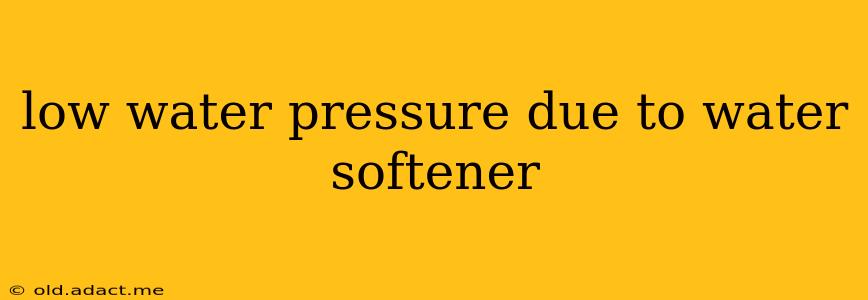Many homeowners enjoy the benefits of a water softener—softer skin, cleaner dishes, and longer-lasting appliances. However, sometimes this beneficial addition can lead to frustratingly low water pressure. This comprehensive guide will explore the common causes of low water pressure stemming from your water softener and offer effective troubleshooting steps and solutions. We'll address common questions and concerns to ensure you can get your water pressure back to normal.
Why is My Water Pressure Low After Installing a Water Softener?
Several factors can contribute to reduced water pressure after installing or using a water softener. The most frequent culprits include:
-
Salt Bridge Formation: A salt bridge occurs when undissolved salt in the brine tank forms a solid bridge, blocking the flow of brine solution. This is a common cause of reduced water softening efficiency and, consequently, low water pressure as the system struggles to function properly.
-
Resin Bed Issues: The resin beads inside the water softener are responsible for ion exchange, softening the water. Over time, these beads can become compacted or contaminated, restricting water flow and leading to lower pressure. This can be due to poor maintenance, excessive sediment in the water, or simply the natural aging of the resin.
-
Clogged or Restricted Water Lines: The water softener itself may be functioning correctly, but any clogs or restrictions in the pipes leading to or from the unit can drastically reduce water pressure throughout your home. This can be caused by mineral buildup, sediment, or even corrosion.
-
Defective Valves or Components: Malfunctioning valves, such as the brine valve or control valve, can impede water flow and reduce pressure. Other internal components within the softener could also be faulty, requiring repair or replacement.
-
Insufficient Water Supply: The problem might not be the water softener itself but rather a lack of sufficient water pressure coming into your home from the main water line. This is particularly relevant if you experience low pressure throughout your house, not just in areas served by softened water.
How Can I Fix Low Water Pressure Caused by My Water Softener?
Let's tackle those potential problems with practical solutions:
1. Addressing Salt Bridges:
- Regular Salt Maintenance: Ensure you regularly check your salt levels and replenish as needed. Avoid overfilling the brine tank, which can contribute to bridge formation.
- Brine Tank Cleaning: If a salt bridge has already formed, you may need to manually break it up. This often involves using a long, sturdy object to carefully break the solidified salt. Always disconnect the power before performing any maintenance.
- Proper Salt Type: Use the correct type of water softener salt, as specified by your softener's manufacturer. Using improper salt can affect performance and contribute to bridge formation.
2. Dealing with Resin Bed Problems:
- Backwashing Regularly: Follow the manufacturer's instructions for regular backwashing. Backwashing helps to flush out sediment and debris that can clog the resin bed.
- Resin Regeneration: A complete regeneration cycle often resolves issues caused by resin degradation. Consult your manual for the correct procedure.
- Resin Replacement: If the resin beads are severely degraded or contaminated, they may need to be replaced. This is a more involved process and often best left to a professional.
3. Inspecting and Cleaning Water Lines:
- Visual Inspection: Carefully examine the water lines leading to and from the softener for any visible obstructions or damage.
- Professional Plumbing Check: If you suspect blockages, a plumber can conduct a thorough inspection and use specialized tools to clear any blockages.
4. Checking Valves and Components:
- Valve Operation: Listen for unusual noises while the softener is running. Grinding or clicking sounds might indicate a faulty valve.
- Professional Repair/Replacement: If a valve or other internal component appears faulty, it's usually best to contact a qualified technician for repair or replacement.
5. Evaluating Your Main Water Supply:
- Check Other Fixtures: If low pressure affects all water sources in your home, the issue originates outside the water softener.
- Contact Your Water Provider: If the problem is with the main water line, contact your local water provider to report the low pressure.
Is Low Water Pressure Always a Water Softener Problem?
No. As mentioned above, low water pressure can have various causes beyond the water softener itself. Always consider other potential sources before assuming your water softener is the sole culprit.
How Often Should I Backwash My Water Softener?
The frequency of backwashing depends on your water usage, water hardness, and the specific model of your water softener. Consult your owner's manual for specific recommendations. Generally, a weekly backwash is a good starting point, but more frequent backwashing may be necessary in some cases.
By systematically addressing these potential issues, you can often restore adequate water pressure and enjoy the benefits of your water softener without compromise. Remember, if you are uncomfortable performing any of these tasks yourself, contacting a qualified plumber is always the safest option.
